
5 Key HubSpot Onboarding Prep Steps to Get Set Up for Marketing Software and CRM Success

HubSpot is an all-encompassing tool that can save you a lot of time while helping pinpoint and deliver sales opportunities and insight into marketing activities that influence your revenue. But it can be daunting figuring out where to start. That’s why we’ve put together this list of 5 key onboarding steps to ensure you’re set up for success.
VIDEO: 5 Steps to Making Your HubSpot Onboarding Experience a Breeze
1. Get Your Team Organized
First, decide on your overall time frame for this move, then break down the onboarding process into different phases of implementation. Then, decide who from your company will need access to the HubSpot account, and what level of access they should have. If it’s someone who should have access to seeing and editing everything, they should be given Super Admin status. Otherwise, consider how much access each user should have for your marketing, sales, and service tools. The most important part of getting started with HubSpot is to get your team excited and prepared. Keep them updated on your progress and emphasize the key tools they can take advantage of once you’re up and running.
2. Customize Your Instance
Once you are ready to actually get into HubSpot and start making changes, the first things you’ll want to do is go through your settings list and fill out some basic information – company name, address, time zone, logo, etc. You’ll also want to decide on what language to use for your GDPR statements. While HubSpot has default verbiage for privacy and consent options, it’s always best to tailor it to your organization. This phase is when you should invite your team to set up their own HubSpot accounts and import your existing contacts.
3. Get Connected & Integrated
Now that the basics of your account are in place, you’ll want to start making connections with your HubSpot account and outside websites or web apps. One account you should definitely take advantage of connecting is Outlook. By connecting these accounts, you’ll be able to access your sales tools directly from your inbox. When it comes to integrating your HubSpot with your website, you’ll need to connect your domain(s) and install the HubSpot plugin or the HubSpot tracking code. You may also want to connect your Google Analytics account, as well as any social media accounts your company has.
4. Get Familiar with Dashboard Reporting
Now that you’ve spent some time getting your HubSpot account in good shape, you’ll be ready to learn even more about all of the tools and integrations HubSpot can offer. Subscribe to the HubSpot user blog to keep up with the latest insights in the world of marketing, and visit the HubSpot Products page to browse available add-ons. Finally, review your Account Dashboard to ensure that it is customized to the needs of your organization. Gaining familiarity with the ability to add and remove any and all reports to your dashboard now will make for a most efficient roll-out.
5. Update Forms, Track Data, and Hit the Ground Running!
Now you’re ready to start making some external changes using HubSpot’s Marketing tools! Replace existing website forms, CTAs, and email templates with ones built in HubSpot so that you can track all of that data in one central location. Just remember, it may take some time for everyone on your team to feel on the same page with their confidence in using this new tool. HubSpot is quite user-friendly, but it does require each user to spend time inside the program and test out its different features. Making HubSpot a regular part of your day-to-day operations will make for a great impact in the long run.
Need help getting up and running with HubSpot or optimizing your HubSpot instance?

Or schedule a few minutes to speak one-on-one with one of our HubSpot experts:
—
You may also be interested in:
Editor’s Picks
If you've been living inside HubSpot like we have, you know the true magic is in the small, hidden tricks—those little shortcuts that save hours and...


Connect with us to discover how we can help your business grow.
.jpg)

